- History / Culture
- Gourmet
Escape from Himeji: Discover Fukusaki's Folklore, Historic Hotel, and Local Delights
Contributor : Kristina
Himeji City is a major tourist attraction thanks to the magnificent Himeji Castle. However, if you find the crowds overwhelming, take a 30-minute train ride from Himeji to the charming and mysterious Fukusaki Town. Simply head north on the Bantan Line from Himeji Station, and in just 30 minutes, you'll arrive at this delightful destination. Let's explore this charming part of Hyogo Prefecture, where you can discover the founder of modern Japanese folklore studies, encounter mystical yokai (supernatural creatures), savor some delicious soba, and more!
Start Your Yokai Adventure in Fukusaki
Fukusaki town is accessible from Osaka or Kobe via the JR Kobe Line. Once on the Kobe Line, you must get off at Himeji Station and transfer to the Bantan Line. From Himeji, take the JR Bantan Line train to "Fukusaki Station."

Lush mountains surround Fukusaki Town
Once there, go to the Fukusaki Town Ekimae Tourist Exchange Center, conveniently located just in front of the station. At the center, you can purchase snacks, get helpful tourist information about Fukusaki Town, and rent an electric bicycle for just 500 yen per day (prices are subject to change). Since the main activities are a bit far for walking, renting a bike is the best way to start your trip! Remember to bring your ID card, as the staff will ask for it when renting a bike.

Visit the Fukusaki Town Ekimae Tourist Exchange Center to rent bicycles!
When you take a ride around, you'll immediately notice fascinating creatures like the "Amabie" benches next to Fukusaki Station. So why is this city associated with Yokai (supernatural creatures)? Let's explore that intriguing connection!
Fukusaki Town - a cradle of Japanese folklore
When we think of the Japanese mythical creatures called "yokai," one might immediately picture "Mizuki Shigeru Road" in Sakaiminato City, Tottori Prefecture, the hometown of Shigeru Mizuki, the creator of the manga "GeGeGe no Kitaro." But what if I told you that this manga probably wouldn't exist if it weren't for a man born in Fukusaki town in the 19th century?
Kunio Yanagita (1875–1962), born and raised in Fukusaki, is revered as the founder and pioneer of Japanese folklore studies. His immense contributions to the field have earned him the title "Father of Japanese Folklore." Yanagita dedicated his life to gathering and transforming traditional stories, legends, and myths into literary works.
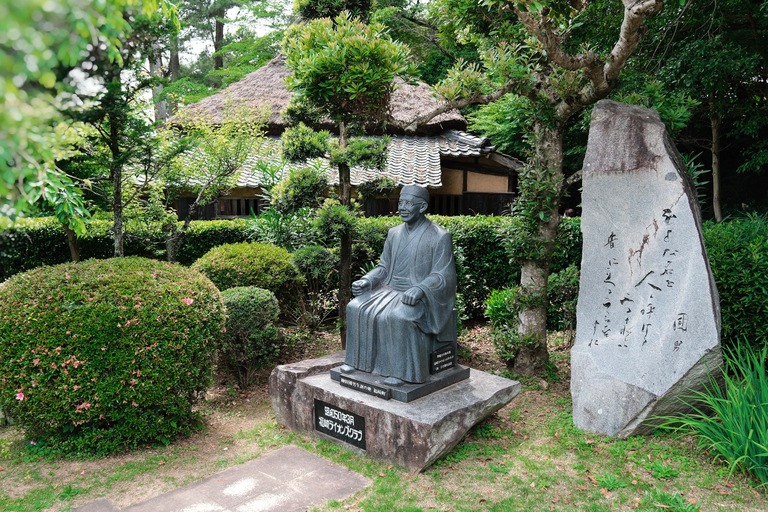
The Monument to Kunio Yanagita - pioneer of Japanese folklore studies
Yokai, or supernatural creatures, are a central focus within the legends and tales examined in this field. Japan is a country rich in legends; in the past, many people would recall and share these stories. However, modern distractions have caused these traditions to fade, leading to a loss of collective memory. Yanagita lamented this decline and wrote books to preserve these tales for younger generations, hoping to spark their interest in the rich tapestry of Japanese folklore. He left behind an impressive array of publications, including the well-known "Tales of Tono" and "Discussions on Yokai."
The legacy of Kunio Yanagita at Tsujikawayama Park
Fukusaki, now renowned as "the town where you can encounter yokai," celebrates Kunio Yanagita's legacy with numerous yokai-themed sculptures scattered throughout the area. This initiative began in 2014 to attract more tourists. The project started at Tsujikawayama Park, close to Yanagita's childhood home and memorial hall.
Mechanized dolls resembling yokai creatures were placed by a murky pond next to the park. If you visit Tsujikawayama Park at 0, 15, 30, and 45 minutes past the hour, you'll encounter Gajiro, also known as the red kappa, emerging from the pond in a lifelike manner. This realistic display has been known to startle children, leading some to cry out loudly. Even I have to admit that it looked very lifelike!
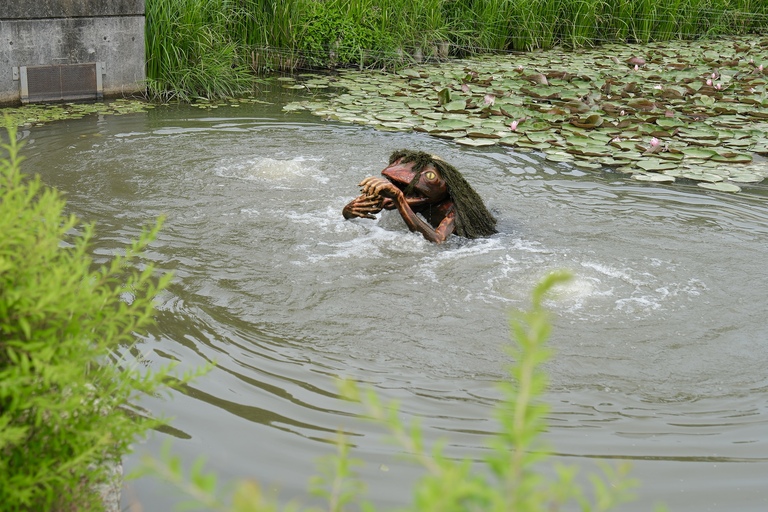
Gajiro, or "red kappa", emerging from the pond
Interestingly, Gajiro's character is unique with his red skin, which differs from the more common green, blue, or black depictions of kappa. Initially, Gajiro's statue was beige, but it was changed to red, inspired by Yanagita's "Tales of Tono," which describes red kappa. This change quickly boosted Gajiro's popularity.

The tengu appears every hour at 5, 20, 35, and 50 minutes past the hour
You can enjoy many other creatures around the park, but the most eye-catching one is an inverted tengu. At 5, 20, 35, and 50 minutes past every hour from 9:05 AM to 6:05 PM, a tengu with long white hair, suspended upside down, emerges from an eerie house 3 meters above the ground. Though the tengu itself might look a bit angry or scary, there is one detail that made me smile - he is holding his favorite treat, dorayaki - a honey pancake sandwich with sweet red bean paste. I did not know that the legendary tengu, the long-nosed supernatural being that inhabits mountainous areas, had a tooth for sweets!
The most miniature house in Japan, Yanagida Kunio's birthplace
Since I was so close to the birthplace of Kunio Yanagita, the father of Japanese folklore, I decided to visit his carefully preserved childhood home. In his memoir, "Furusato Nanajunen" (Seventy Years of Hometown), Yanagita wrote, "My house is the smallest in Japan." He added, "Indeed, it can be said that my passion for folklore studies was born from the destiny of living in this tiny house."

Find the birthplace of Kunio Yanagita just next to Tsujikawayama Park
While his house may appear compact, it was a typical farmhouse of that era, consisting of two 4.5-tatami mat rooms (approximately 7.29 square meters each) and two 3-tatami mat rooms (approximately 4.86 square meters each). Yanagita must have experienced very crowded living conditions as the sixth son in his family. Reflecting on his life, Yanagita likely often recalled his childhood days in this tiny home, which resonated with the folklore he collected from across Japan.

The Kanzaki County Historical and Folklore Museum offers free admission
After visiting the well-preserved birthplace of Kunio Yanagita, head to the Kanzaki County Historical and Folklore Museum to delve deeper into the history of Fukusaki Town. Here, you can see exhibits on the town's history and daily-life tools from around when Yanagita's tiny house was built.

The details of the museum's building
The museum's design, featuring a Greek-style balcony, is a striking wooden structure with a tiled roof and intricate carvings inside and out. This makes it a fascinating site for architecture enthusiasts. The museum building itself was originally constructed in 1886. It served as an official government office but faced demolition due to aging. However, after a successful preservation movement, it was relocated and restored to its current location.
Trying the famous Mochimugi (sticky barley) Japanese noodles
I started feeling weary, so I decided to have a well-deserved lunch and try the famous Mochimugi (sticky barley) Japanese noodles, also known as soba, at one of the local restaurants just across Tsujikawayama Park. I had never been a big fan of soba, so I was skeptical about it, but now I understand why this particular type of soba is so popular among the locals!

The famous Mochimugi (sticky barley) Japanese noodles at Mochimugi-no-Yakata
In Fukusaki Town, mochimugi or mochi barley was extensively cultivated around the beginning of the Showa era (1926-1989) and was mainly consumed as dumplings. Over time, its cultivation dwindled, but efforts to revive it as a local specialty led to the development of "mochimugi noodles."
Mochimugi noodles offer a satisfying texture similar to pasta yet distinctly chewy like mochi. This unique texture is not found in soba or udon noodles. Plus due to their high dietary fiber content, mochimugi noodles are also very healthy.

Cheap and healthy lunch at Mochimugi-no-Yakata
You can experience making these unique mochi barley noodles yourself ! The menu of the place I went to included a variety of mochi barley dishes such as set meals, cold and hot noodles, etc. I decided on a set menu since I was hungry. But the size of the dish was even more significant than I expected - mochi barley tea, mochi barley rice, tempura, sashimi, and various other side dishes came with the meal and filled me up. For children, there's the "Chibikko Set," which includes mini kitsune mochimugi noodles, onigiri rice balls, and soft serve ice cream.

A “Kappa cider”- a drink made with yuzu (a citrus fruit produced in Hyogo Prefecture)
The other interesting things I noticed in this restaurant were a “Kappa cider”- a drink made with yuzu (a citrus fruit produced in Hyogo Prefecture)—that has a refreshing taste, and the mochimugi ice cream, which I have not tried since I was already pretty full, to be honest.
Yokai Benches and Exploring Fukusaki
I cycled around the city to get some exercise, finding all the yokai benches scattered throughout.
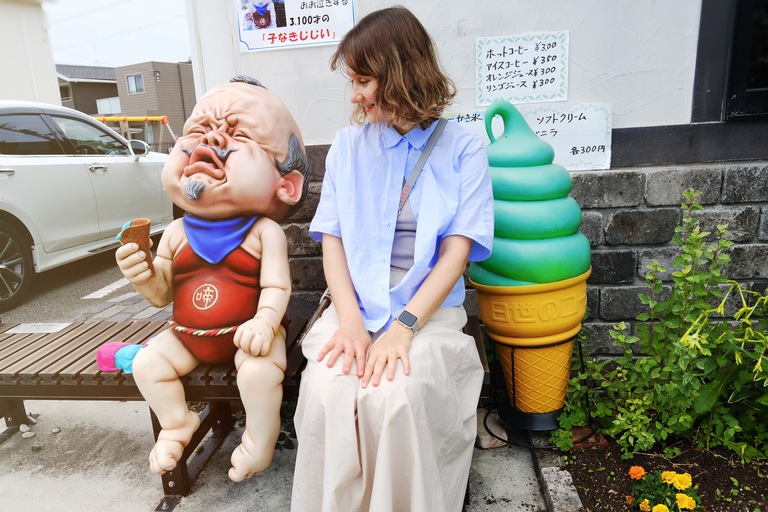
Try to find all the Yokai benches scattered throughout Fukusaki town!
These benches are based on the works of Kunio Yanagita, such as "Yokai Discussions."There are the "Yuki Onna" (Snow Woman), the tengu in an office costume working hard on his computer, a muscular ogre taking selfies, and many more. You can take funny pictures with them and even use the face-cutout board for a fun photo.
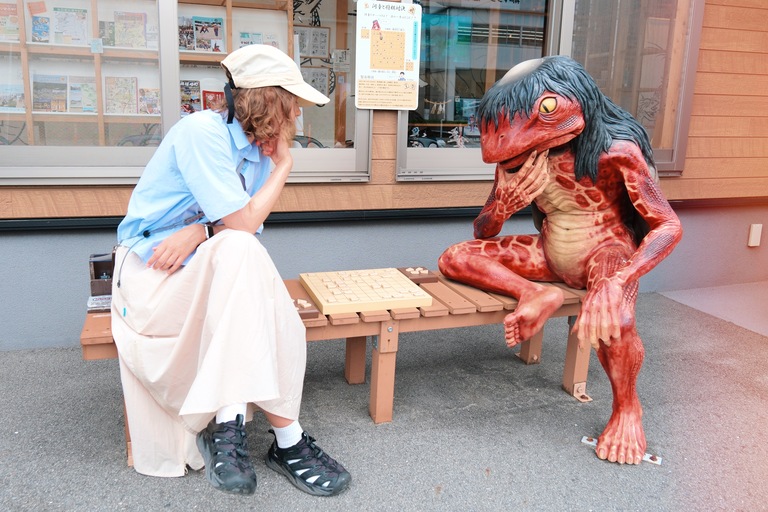

To find all yokai, pick up a map showing their locations at the tourist exchange center near Fukusaki Station
There are 21 benches in total, and I recommend picking up a map at the tourist exchange center I mentioned at the beginning of this article or searching "yokai bench" on Google Maps to find them all!
Staying for a night at a 300-year-old Japanese residence
Fukusaki is an excellent destination for a day trip. Still, I recommend to stay overnight to experience one of the most beautiful stays of your life at an old, magnificent Japanese house.
"NIPPONIA Harima Fukusaki Library Maison" is a renovated residence that was once the home of prominent local officials, the Miki family. Construction of their home began in 1697 and continued in stages through the early Meiji Period (1868–1912). It is the first hotel in Japan designated as an important tangible cultural property by Hyogo Prefecture.

Stay at a renovated 300-year-old Japanese residence
Initially owned by the Miki family and managed by an elderly lady from the family alone, the residence was transferred to Fukusaki Town in 2004. It must have been quite a challenge given its vast grounds and buildings! Now, thanks to the efforts of the town and Hyogo Prefecture, it stands as one of the best-preserved Edo-period (1603–1867) houses in the prefecture.
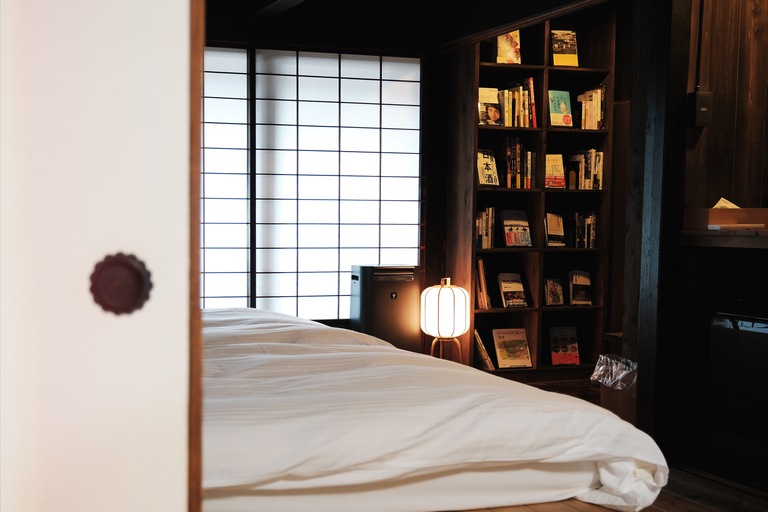
The gorgeous interiors of the residence previously owned by the Miki family
There are seven types of guest rooms in total: five inside the Miki family residence and two rooms in the former Tsujikawa post office. These rooms are full of history and offer a peaceful stay without modern distractions like TVs or clocks. The central theme of the NIPPONIA Harima Fukusaki Library Maison is the approximately 500 books available in the entire hotel. I particularly enjoyed the room with a wall bookshelf that reaches the ceiling—a perfect place to stay for a night or even a week, surrounded by books and quietly exploring the area.

One of the rooms at the NIPPONIA Harima Fukusaki Library Maison
The staff mentioned that some guests from overseas even come here for a wedding ceremony, as the whole space can be rented out for a small wedding party of 10-20 people. It sounds amazing!

Experience the countless details waiting to be explored in every room!
This place also allows you to experience the childhood memories of Kunio Yanagita, who immersed himself in books when he spent a year there at the age of 11. Later, in his book "Seventy Years in My Hometown," he reminisced, "The foundation of my trivial knowledge was formed in just this year." Now, each room of the NIPPONIA Harima Fukusaki Library Maison has bookshelves to recreate this atmosphere.
Conclusion
Fukusaki Town offers a unique blend of historical charm, cultural heritage, and delightful local experiences, making it a hidden gem worth exploring. From the fascinating yokai sculptures and the legacy of Kunio Yanagita to the soothing ambiance of the NIPPONIA Harima Fukusaki Library Maison, there is something for everyone to enjoy. Whether you’re savoring the mochimugi noodles, cycling around the town to find whimsical yokai benches, or immersing yourself in the rich folklore at Yanagita’s birthplace, Fukusaki provides a tranquil escape from the hustle and bustle of more crowded tourist spots.
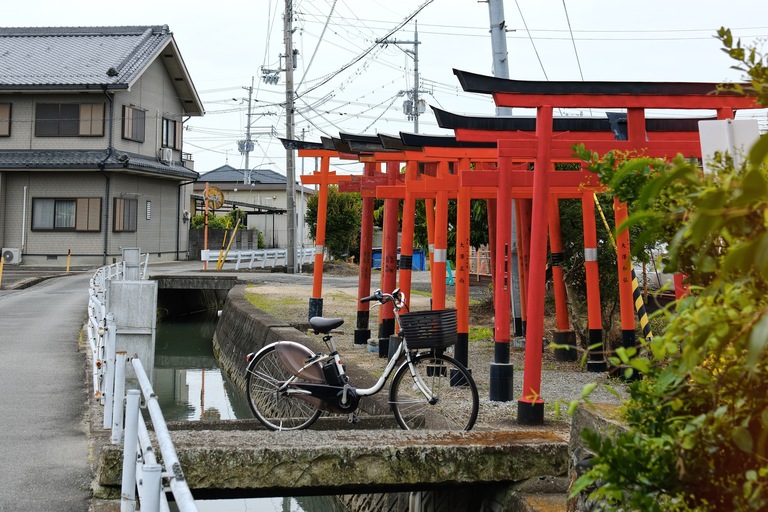
The quiet streets of Fukusaki town
A day trip to Fukusaki is undoubtedly rewarding, but staying overnight allows you to fully experience the serene beauty and deep cultural roots of this remarkable town. So, next time you find yourself in the Hyogo Prefecture, take the road less traveled and discover the enchanting world of Fukusaki Town. You'll leave with unforgettable memories and perhaps a newfound appreciation for the timeless stories and legends that shaped Japan's cultural landscape.
Date : 2024.03.27



